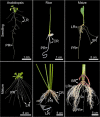Deconstructing the root system of grasses through an exploration of development, anatomy and function
- PMID: 35092025
- PMCID: PMC9303260
- DOI: 10.1111/pce.14270
Deconstructing the root system of grasses through an exploration of development, anatomy and function
Abstract
Well-adapted root systems allow plants to grow under resource-limiting environmental conditions and are important determinants of yield in agricultural systems. Important staple crops such as rice and maize belong to the family of grasses, which develop a complex root system that consists of an embryonic root system that emerges from the seed, and a postembryonic nodal root system that emerges from basal regions of the shoot after germination. While early seedling establishment is dependent on the embryonic root system, the nodal root system, and its associated branches, gains in importance as the plant matures and will ultimately constitute the bulk of below-ground growth. In this review, we aim to give an overview of the different root types that develop in cereal grass root systems, explore the different physiological roles they play by defining their anatomical features, and outline the genetic networks that control their development. Through this deconstructed view of grass root system function, we provide a parts-list of elements that function together in an integrated root system to promote survival and crop productivity.
Keywords: Grasses; Oryza sativa; Zea mays; embryonic roots; environmental stress; postembryonic roots; root development; root system architecture.
© 2022 The Authors. Plant, Cell & Environment published by John Wiley & Sons Ltd.
Conflict of interest statement
The authors declare that there are no conflict of interests.
Figures




Similar articles
-
Genetic and Hormonal Blueprint of Shoot-Borne Adventitious Root Development in Rice and Maize.Plant Cell Physiol. 2023 Jan 30;63(12):1806-1813. doi: 10.1093/pcp/pcac084. Plant Cell Physiol. 2023. PMID: 35713294 Review.
-
Protective roles of nitric oxide on seed germination and seedling growth of rice (Oryza sativa L.) under cadmium stress.Ecotoxicol Environ Saf. 2014 Oct;108:114-9. doi: 10.1016/j.ecoenv.2014.05.021. Epub 2014 Jul 19. Ecotoxicol Environ Saf. 2014. PMID: 25046853
-
Influence of nanoscale micro-nutrient α-Fe2O3 on seed germination, seedling growth, translocation, physiological effects and yield of rice (Oryza sativa) and maize (Zea mays).Plant Physiol Biochem. 2021 May;162:564-580. doi: 10.1016/j.plaphy.2021.03.023. Epub 2021 Mar 13. Plant Physiol Biochem. 2021. PMID: 33773232
-
Grasses suppress shoot-borne roots to conserve water during drought.Proc Natl Acad Sci U S A. 2016 Aug 2;113(31):8861-6. doi: 10.1073/pnas.1604021113. Epub 2016 Jul 15. Proc Natl Acad Sci U S A. 2016. PMID: 27422554 Free PMC article.
-
From weeds to crops: genetic analysis of root development in cereals.Trends Plant Sci. 2004 Jan;9(1):42-8. doi: 10.1016/j.tplants.2003.11.003. Trends Plant Sci. 2004. PMID: 14729218 Review.
Cited by
-
PtrABR1 Increases Tolerance to Drought Stress by Enhancing Lateral Root Formation in Populus trichocarpa.Int J Mol Sci. 2023 Sep 6;24(18):13748. doi: 10.3390/ijms241813748. Int J Mol Sci. 2023. PMID: 37762051 Free PMC article.
-
The value of early root development traits in breeding programs for biomass yield in perennial ryegrass (Lolium perenne L.).Theor Appl Genet. 2025 Jan 21;138(1):31. doi: 10.1007/s00122-024-04797-5. Theor Appl Genet. 2025. PMID: 39836302 Free PMC article.
-
Choreographing root architecture and rhizosphere interactions through synthetic biology.Nat Commun. 2024 Feb 14;15(1):1370. doi: 10.1038/s41467-024-45272-5. Nat Commun. 2024. PMID: 38355570 Free PMC article. Review.
-
Physical Mapping of QTLs for Root Traits in a Population of Recombinant Inbred Lines of Hexaploid Wheat.Int J Mol Sci. 2023 Jun 22;24(13):10492. doi: 10.3390/ijms241310492. Int J Mol Sci. 2023. PMID: 37445670 Free PMC article.
-
Bioenergy sorghum nodal root bud development: morphometric, transcriptomic and gene regulatory network analysis.Front Plant Sci. 2024 Oct 21;15:1456627. doi: 10.3389/fpls.2024.1456627. eCollection 2024. Front Plant Sci. 2024. PMID: 39498396 Free PMC article.
References
-
- Abbe, E.C. & Stein, O.L. (1954) The growth of the shoot apex in maize: embryogeny. American Journal of Botany, 41, 285–293.
-
- Abe, M. , Kuroshita, H. , Umeda, M. , Itoh, J.‐I. & Nagato, Y. (2008) The rice flattened shoot meristem, encoding CAF‐1 p150 subunit, is required for meristem maintenance by regulating the cell‐cycle period. Developmental Biology, 319, 384–393. - PubMed
-
- Ahmed, M.A. , Zarebanadkouki, M. , Kaestner, A. & Carminati, A. (2016) Measurements of water uptake of maize roots: the key function of lateral roots. Plant and Soil, 398, 59–77.
Publication types
MeSH terms
LinkOut - more resources
Full Text Sources

